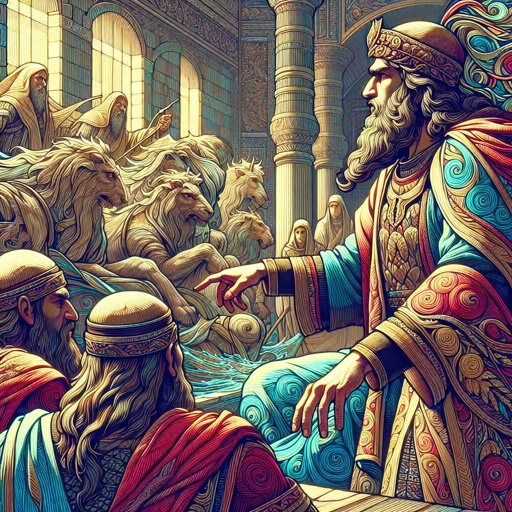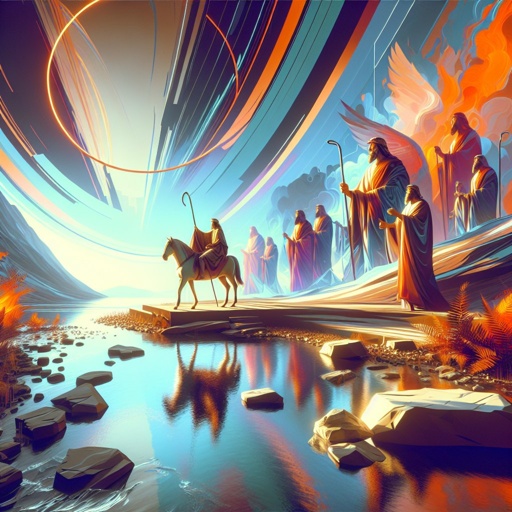What does Numbers 13:1 mean?
"And the LORD spake unto Moses, saying," - Numbers 13:1

Numbers 13:1 - "And the LORD spake unto Moses, saying,"
Numbers 13:1 (KJV) - "And the Lord spake unto Moses, saying,"
This verse serves as the introductory phrase to a significant event in the book of Numbers. It marks the beginning of the Israelites' journey to explore the Promised Land, a pivotal moment in their history. The verse signifies the direct communication between God and Moses, highlighting the divine authority and guidance that the Israelites received throughout their journey.
The book of Numbers is primarily concerned with the journey of the Israelites from Mount Sinai to the border of the Promised Land. It details their trials, triumphs, and various experiences as they traveled through the wilderness for 40 years. In the larger context of the verse, it is essential to understand the overarching themes and context of the book of Numbers.
The theme of obedience to God's commands is prevalent throughout the book of Numbers. From the very beginning, the Israelites were called to follow God's instructions, including the organization of the tribes, the manner of worship, and their journey to the Promised Land. In Numbers 13:1, the Lord speaking to Moses signifies the divine authority and the importance of following God's guidance. The verse sets the stage for the obedience and faithfulness that will be tested and demonstrated throughout the Israelites' journey.
Another significant theme in the book of Numbers is the concept of faith and trust in God. The journey to explore the Promised Land was a testament to the Israelites' faith in God's promises. Despite the challenges and uncertainties they faced, God's guidance and provision remained constant. Numbers 13:1 establishes the foundation for the Israelites' journey, emphasizing the importance of trusting in God's plan and promises.
Furthermore, the verse symbolizes the intimate relationship between God and Moses, as well as the leadership role of Moses among the Israelites. Throughout the book of Numbers, Moses serves as the intermediary between God and the people, receiving divine instructions and guidance on their behalf. In Numbers 13:1, the Lord speaking directly to Moses signifies the close connection and communication between the divine and the human, underscoring Moses' pivotal role as a leader and prophet.
The significance of Numbers 13:1 also extends to the broader biblical narrative and the portrayal of God's faithfulness and sovereignty. The verse illustrates God's active involvement in the lives of his people, providing guidance, instruction, and assurance. It serves as a reminder of God's continuous presence and communication with humanity, reinforcing the overarching biblical message of God's faithfulness and sovereignty.
In conclusion, Numbers 13:1 holds profound meaning and significance within the larger context of the book of Numbers and the biblical narrative as a whole. It reflects themes of obedience, faith, trust, and the intimate relationship between God and his people. The verse marks the beginning of a significant event in the history of the Israelites, highlighting the divine guidance and faithfulness that sustained them throughout their journey. As such, Numbers 13:1 serves as a powerful reminder of God's sovereignty and active involvement in the lives of his people, inspiring faith and trust in his promises.
Numbers 13:1 Artwork

Numbers 13:1 - "And the LORD spake unto Moses, saying,"

Numbers 1:13 - "Of Asher; Pagiel the son of Ocran."

Numbers 13:13 - "Of the tribe of Asher, Sethur the son of Michael."

Numbers 13:10 - "Of the tribe of Zebulun, Gaddiel the son of Sodi."

Numbers 33:13 - "And they departed from Dophkah, and encamped in Alush."

Numbers 13:8 - "Of the tribe of Ephraim, Oshea the son of Nun."

Numbers 13:6 - "Of the tribe of Judah, Caleb the son of Jephunneh."

Numbers 13:12 - "Of the tribe of Dan, Ammiel the son of Gemalli."

Numbers 13:14 - "Of the tribe of Naphtali, Nahbi the son of Vophsi."

Numbers 13:15 - "Of the tribe of Gad, Geuel the son of Machi."

Numbers 13:9 - "Of the tribe of Benjamin, Palti the son of Raphu."

Numbers 13:7 - "Of the tribe of Issachar, Igal the son of Joseph."

Numbers 13:5 - "Of the tribe of Simeon, Shaphat the son of Hori."

Numbers 26:13 - "Of Zerah, the family of the Zarhites: of Shaul, the family of the Shaulites."

Numbers 13:25 - "And they returned from searching of the land after forty days."

Numbers 13:4 - "And these were their names: of the tribe of Reuben, Shammua the son of Zaccur."

Numbers 13:11 - "Of the tribe of Joseph, namely, of the tribe of Manasseh, Gaddi the son of Susi."

Numbers 10:13 - "And they first took their journey according to the commandment of the LORD by the hand of Moses."

Numbers 20:13 - "This is the water of Meribah; because the children of Israel strove with the LORD, and he was sanctified in them."

Numbers 4:13 - "And they shall take away the ashes from the altar, and spread a purple cloth thereon:"

Numbers 2:13 - "And his host, and those that were numbered of them, were fifty and nine thousand and three hundred."

Numbers 35:13 - "And of these cities which ye shall give six cities shall ye have for refuge."

Numbers 13:18 - "And see the land, what it is; and the people that dwelleth therein, whether they be strong or weak, few or many;"

Numbers 31:13 - "¶ And Moses, and Eleazar the priest, and all the princes of the congregation, went forth to meet them without the camp."

Numbers 1:7 - "Of Judah; Nahshon the son of Amminadab."

Numbers 1:15 - "Of Naphtali; Ahira the son of Enan."

Numbers 1:14 - "Of Gad; Eliasaph the son of Deuel."

Numbers 1:11 - "Of Benjamin; Abidan the son of Gideoni."

Numbers 1:9 - "Of Zebulun; Eliab the son of Helon."

Numbers 1:6 - "Of Simeon; Shelumiel the son of Zurishaddai."